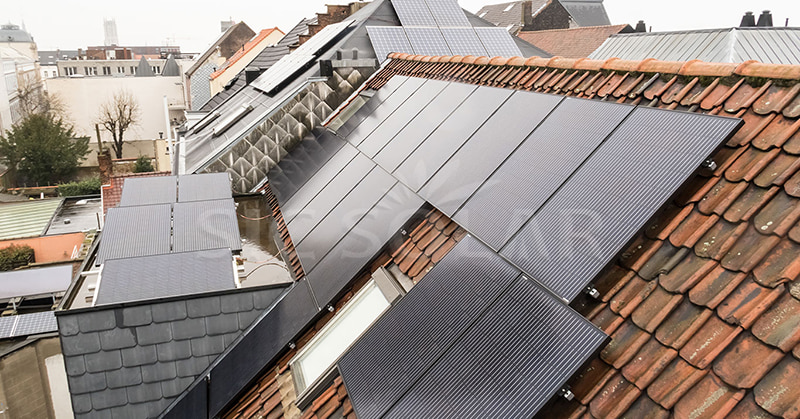With the increasing popularity of solar energy, many homeowners and businesses are turning to solar panel installations as a way to cut down on energy costs and reduce their environmental impact. One common concern, however, is whether installing solar panels on a pitched roof might affect the roof’s structure.

Understanding the Basics of Pitched Roof Installations A pitched roof, with its sloped design, is actually ideal for solar installations because of its natural angle. Solar panels are typically mounted on the roof using a specialized racking or mounting system that attaches directly to the roof’s structure.
While this might raise concerns about potential damage or weakening of the roof, the reality is that when installed properly, solar panels can be integrated into the roof without causing any negative impact.
Key Considerations When Installing Solar Panels on a Pitched Roof
- Weight and Load Distribution One of the main concerns when installing solar panels is the added weight they bring to the roof. While solar panels themselves are relatively lightweight, the mounting hardware, wiring, and other components do add some load.
However, proper installation ensures that this weight is evenly distributed across the roof structure. Most modern pitched roofs are designed to handle additional weight, as they are built with specific load-bearing capacities. If you have concerns about the load capacity, a structural engineer can assess your roof to confirm that it can safely support the solar panels and mounting system.
SIC Solar mounting systems are engineered to be both lightweight and durable, helping to minimize the added weight while maintaining strong, secure connections to the roof. Their systems are designed to ensure that the panels are securely fastened without overburdening the roof structure.
- Penetrations in the Roof To attach solar panels to a pitched roof, penetrations are typically made into the roof to anchor the mounting brackets. These penetrations can potentially lead to water leakage if not properly sealed. It’s essential to work with a professional installer who uses high-quality materials to seal the holes and ensure they remain watertight.
SIC Solar mounting systems are designed with high-quality flashing and sealing methods to prevent water from entering the roof during installation. This added layer of protection ensures that the roof’s integrity is maintained and that no leaks or damage occur after the panels are installed.
- Structural Support and Reinforcements In some cases, particularly with older roofs or those showing signs of wear and tear, additional structural support may be needed before installing solar panels. If the roof trusses or beams appear weakened or damaged, a professional installer may recommend reinforcing the roof structure to ensure it can support the weight of the panels.
However, in most modern homes and commercial buildings, the roof is built with the necessary load-bearing capacity to support solar panels. Using a well-designed system like those from SIC Solar can help distribute the weight evenly and prevent undue stress on any one area of the roof.
- Roof Orientation and Angle The orientation and slope of the roof play a significant role in determining the efficiency of solar panel installations. Pitched roofs typically provide a natural angle that helps panels capture sunlight more effectively, reducing the need for complex mounting adjustments.
In some cases, however, the angle of the roof may need to be adjusted to achieve optimal panel orientation. SIC Solar adjustable mounting systems allow panels to be positioned at the best angle, helping to maximize energy production without affecting the roof’s structure.
How Solar Panels Can Actually Protect Your Roof While there are concerns about the potential impact of solar panels on a pitched roof, they can actually have a protective effect in some cases. By covering parts of the roof, solar panels can shield it from the elements, reducing wear and tear from weather conditions like rain, snow, and direct sunlight. This can extend the lifespan of the roof by providing a protective layer that prevents exposure to the elements.
For roofs with shingles or tiles, solar panels can offer an added layer of protection from harsh weather, potentially reducing the need for repairs and maintenance over time.
How SIC Solar Mounting Systems Help Protect Your Roof SIC Solar designs and manufactures mounting systems that ensure the secure attachment of solar panels to your roof while safeguarding the roof structure. Their mounting systems are engineered to:
- Distribute weight evenly: The design of SIC Solar mounting systems helps to spread the weight of the panels across the roof, preventing stress on any one area.
- Minimize roof penetrations: With thoughtful engineering and high-quality sealing materials, SIC Solar systems reduce the risk of water infiltration, ensuring your roof remains watertight.
- Provide flexibility: Whether your roof is steeply pitched or relatively flat, SIC Solar adjustable mounting solutions allow you to optimize the angle of your panels without compromising the integrity of the roof.
- Offer durable materials: Made with corrosion-resistant materials, SIC Solar mounting systems are designed to withstand the elements, ensuring long-lasting performance without negatively impacting your roof.
Will Solar Panels Affect the Roof Structure in the Long Term? When installed correctly, solar panels will not cause significant long-term damage to a pitched roof. In fact, they can help protect the roof from weathering and reduce the overall need for roof repairs. However, poor installation or improper sealing can lead to problems such as leaks or structural stress.
By working with experienced installers and using high-quality systems like those from SIC Solar, you can rest assured that your roof will remain secure and intact while benefiting from the added energy production of solar panels.